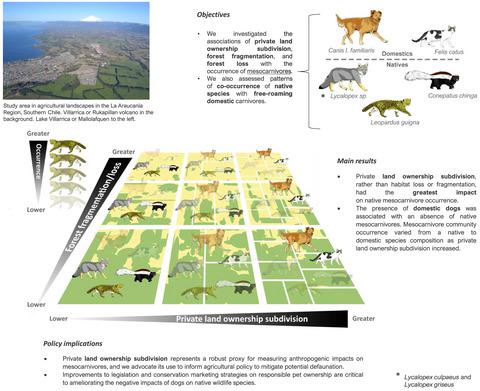当前位置:
X-MOL 学术
›
J. Appl. Ecol.
›
论文详情
Our official English website, www.x-mol.net, welcomes your
feedback! (Note: you will need to create a separate account there.)
Land use intensification coupled with free-roaming dogs as potential defaunation drivers of mesocarnivores in agricultural landscapes
Journal of Applied Ecology ( IF 5.0 ) Pub Date : 2021-09-13 , DOI: 10.1111/1365-2664.14026 Nicolás Gálvez 1 , José Infante 1, 2 , Adrián Fernandez 1 , Jesús Díaz 1 , Lisanne Petracca 3
中文翻译:

土地利用集约化加上自由漫游的狗作为农业景观中中型食肉动物的潜在动物区系灭绝驱动因素
更新日期:2021-09-13
Journal of Applied Ecology ( IF 5.0 ) Pub Date : 2021-09-13 , DOI: 10.1111/1365-2664.14026 Nicolás Gálvez 1 , José Infante 1, 2 , Adrián Fernandez 1 , Jesús Díaz 1 , Lisanne Petracca 3
Affiliation

|
- Land use intensification, by which habitat loss, habitat fragmentation and increased land ownership subdivision occurs, represents one of the largest threats to biodiversity. The extent to which land use intensification affects the presence of native mesocarnivores is largely unexplored, with great implications for all working landscapes where agriculture and native wildlife co-occur.
- We obtained mesocarnivore detection/non-detection data from 180 4-km2 sampling units in agricultural landscapes of southern Chile from January to April 2019. We used these data to (a) investigate the associations of private land ownership subdivision, forest fragmentation and forest loss with the occurrence of mesocarnivores using single-species occupancy models, (b) assess patterns of mesocarnivore co-occurrence with free-roaming domestic mesocarnivores (e.g. cats and dogs) using two-species occupancy models and (c) determine whether co-occurrence of native and domestic mesocarnivores led to alterations in species’ temporal activity.
- Land ownership subdivision, rather than habitat loss or fragmentation, had the greatest impact on native mesocarnivore occurrence, with some influence of domestic dogs. Mesocarnivore community occurrence varied from a native to domestic species composition as private land ownership subdivision increased. Native mesocarnivores altered their behaviour temporally when co-occurring with domestics. Lastly, the presence of domestic dogs was associated with an absence of native mesocarnivores, which merits further investigation into the contribution of domestic dogs to a defaunation process in agricultural areas.
- Policy implications. Our evidence supports focusing efforts in three key dimensions to advance biodiversity conservation in agricultural landscapes. First, private land subdivision represents a robust proxy for measuring anthropogenic impacts on mesocarnivores, and we advocate its use to inform agricultural policy to mitigate a potential defaunation process. Second, there is a need to further engage with landowners and evaluate values, motivation, willingness and action to protect remnant native vegetation and slow land use change. And, lastly, improvements to legislation and conservation marketing strategies on responsible pet ownership are critical to ameliorating the negative impacts of dogs on native wildlife species.
中文翻译:

土地利用集约化加上自由漫游的狗作为农业景观中中型食肉动物的潜在动物区系灭绝驱动因素
- 土地利用集约化导致栖息地丧失、栖息地破碎化和土地所有权细分增加,是对生物多样性的最大威胁之一。土地利用集约化对本地中型食肉动物存在的影响程度在很大程度上是未知的,这对所有农业和本地野生动物共存的工作环境具有重大影响。
- 2019 年 1 月至 4 月,我们从智利南部农业景观的180 个 4 公里2采样单元中获得了中型食肉动物检测/非检测数据。我们使用这些数据来 (a) 调查私有土地所有权细分、森林破碎化和森林的关联使用单一物种占用模型评估中型食肉动物与中型食肉动物发生的损失,(b) 使用两种物种占用模型评估中型食肉动物与自由漫游的家养中型食肉动物(例如猫和狗)共存的模式,以及 (c) 确定是否共存本土和家养的中型食肉动物导致物种时间活动的改变。
- 土地所有权细分,而不是栖息地丧失或破碎,对本地中型食肉动物的发生影响最大,家犬也有一些影响。随着私人土地所有权细分的增加,中食肉动物群落的发生从本地物种组成到家养物种组成各不相同。本地中食肉动物在与家养动物同时出现时会暂时改变它们的行为。最后,家犬的存在与本地中食肉动物的缺乏有关,这值得进一步调查家犬对农业地区动物区系丧失过程的贡献。
- 政策影响。我们的证据支持将重点放在三个关键方面,以促进农业景观中的生物多样性保护。首先,私人土地细分是衡量人为对中型食肉动物影响的有力替代,我们提倡使用它来为农业政策提供信息,以减轻潜在的动物区系丧失过程。其次,需要进一步与土地所有者接触并评估价值、动机、意愿和行动,以保护剩余的原生植被和减缓土地利用变化。最后,关于负责任的宠物所有权的立法和保护营销策略的改进对于减轻狗对本地野生动物物种的负面影响至关重要。











































 京公网安备 11010802027423号
京公网安备 11010802027423号